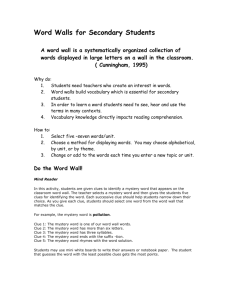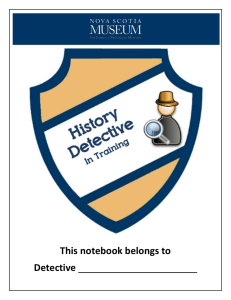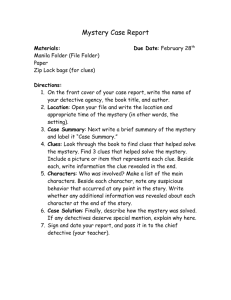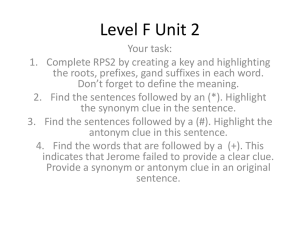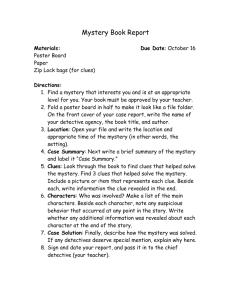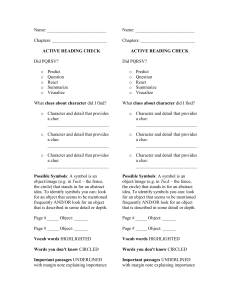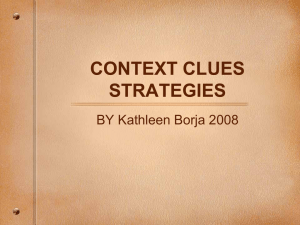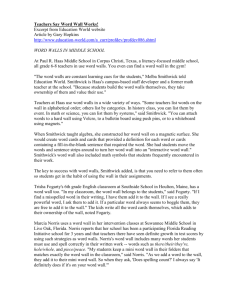Lesson 1 Word Wall
advertisement
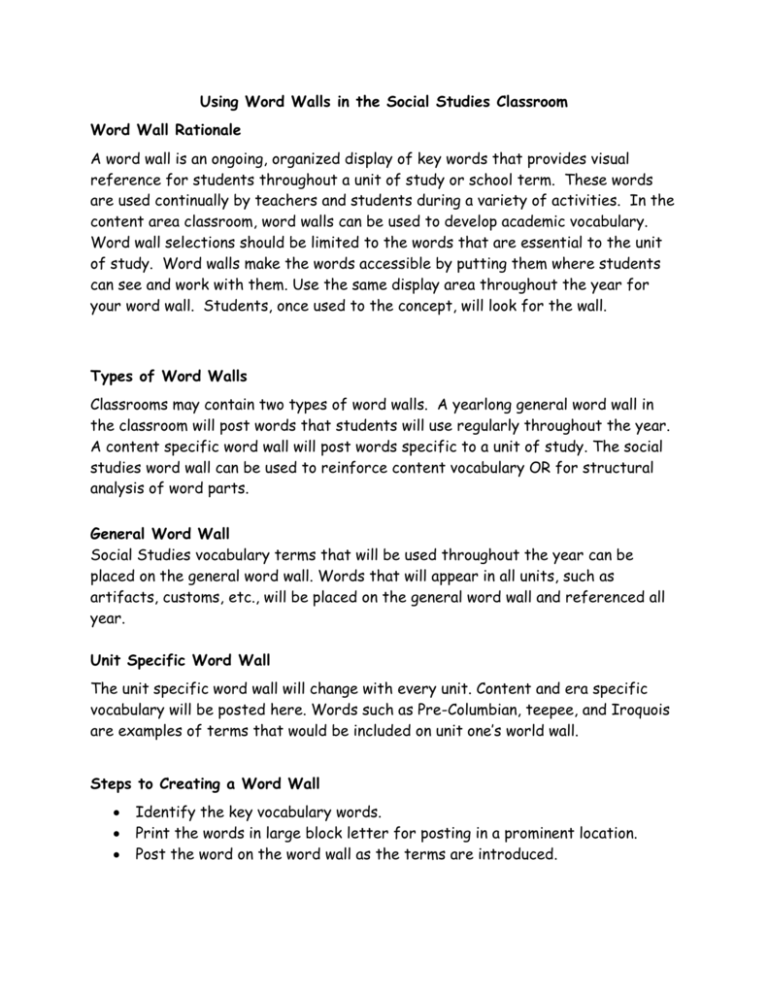
Using Word Walls in the Social Studies Classroom Word Wall Rationale A word wall is an ongoing, organized display of key words that provides visual reference for students throughout a unit of study or school term. These words are used continually by teachers and students during a variety of activities. In the content area classroom, word walls can be used to develop academic vocabulary. Word wall selections should be limited to the words that are essential to the unit of study. Word walls make the words accessible by putting them where students can see and work with them. Use the same display area throughout the year for your word wall. Students, once used to the concept, will look for the wall. Types of Word Walls Classrooms may contain two types of word walls. A yearlong general word wall in the classroom will post words that students will use regularly throughout the year. A content specific word wall will post words specific to a unit of study. The social studies word wall can be used to reinforce content vocabulary OR for structural analysis of word parts. General Word Wall Social Studies vocabulary terms that will be used throughout the year can be placed on the general word wall. Words that will appear in all units, such as artifacts, customs, etc., will be placed on the general word wall and referenced all year. Unit Specific Word Wall The unit specific word wall will change with every unit. Content and era specific vocabulary will be posted here. Words such as Pre-Columbian, teepee, and Iroquois are examples of terms that would be included on unit one’s world wall. Steps to Creating a Word Wall Identify the key vocabulary words. Print the words in large block letter for posting in a prominent location. Post the word on the word wall as the terms are introduced. Do not overcrowd the word wall. You may want to remove words as the unit progresses or you may want to display words by unit and then remove the entire word wall when the unit is completed. Create a visually cohesive wall so that students perceive it as a “collection” of words and it is obvious as to how the words are organized. Note: For classrooms with very limited wall space, words could be placed on chart paper and displayed. In addition, the teacher would need to put the words on cards and put together as a set for students to use for vocabulary activities at their desk. Interactive Word Work The key to successful word walls is the word “interactive.” It is a tool to use, not just a display. Students need to actively interact with the word wall. Make word wall activities a regular and predictable part of the classroom routine. They make for natural class openers or closers. The word wall activity should be only 5-10 minutes in length unless incorporated with a larger activity. Regularly review the terms on the Word Wall. Have students read them aloud as a “warm up” exercise. Frequently call on students to “refresh” their classmates’ memories of the definitions of these words. Reinforce these vocabulary words by including them in learning games and activities. Interaction includes: Continually add words encountered to the wall. Expanding the students’ understanding of how words work (i.e. sketching the definitions, use in a sentence, crossword puzzles, “dissecting”, word mapping, semantic mapping and identifying structural patterns). Engage the students in a “learning conversation,” inviting them to discuss the features that they notice and how the word is connected to the other words. Use a variety of activities to review words. Word Wall Interactions! 1. Student Created Vocabulary Cards Directions: Have students fold a standard piece of plain white paper into four equal rectangles. The top left box is for the focus word and its definition. The top right hand box is for examples (words and phrases—no sentences!) The bottom left box is for an illustration with labels (should be student created.) The bottom right can be used for Non-examples (Antonyms) OR specific examples (this works better for content vocabulary.) Focus Word: Geography Students may keep their vocabulary cards in their social studies folders for reference. Geography: the science of natural and human features of Earth’s surface, and its climate and lifeforms. Natural Landforms/land Bodies of water Climate Human Culture Customs Iroquois Heavily wooded Rivers/Lakes Harsh winters Longhouses Baskets Lacrosse Concept Circle Directions: This activity should be used after students have had time to work with their terms. It’s a great review or extension activity. Using the template attached, the teacher uses new, but familiar vocabulary to reinforce terms or concepts. The Circle can be used in different ways. Review terms: Teacher gives the topic; students come up with four terms that describe it. Concept Review: Teacher gives the four terms, students identify the concept relationship. Describe or name the topic: ____Iroquois Lacrosse Longhouses Palisades Three Sisters Mind Reader In this activity, students are given clues to identify a mystery word that appears on the classroom word wall. The teacher selects a mystery word and then gives the students five clues for identifying the word. Each successive clue should help students narrow down their choice. As you give each clue, students should select one word from the word wall that matches the clue. For example, the mystery word is historian. Clue 1: Clue 2: Clue 3: Clue 4: Clue 5: The mystery word is one of the word wall words. The mystery word has more than six letters. The mystery word has three syllables. The mystery word relates to a person who studies the past. The mystery word After you have given the five clues, have students show their responses. Which student(s) guessed the mystery word with the fewest possible clues? Each student who guesses the correct word at the earliest possible clue earns a clue. Tally points at the end of the game to determine which students are the winners. Hot Seat This activity can be used as a whole-class activity. If you teach students who can work independently, you might use it as a small group or pair activity once students are familiar with the activity’s rules. In this activity, one student is selected to come to the front of the class and take the “hot seat.” The hot seat is located a few feet in front of the whiteboard or chart. The students sit in a chair facing his or her classmates and with his or her back to the board or chart. The student also should have a clear view of the class word wall. The teacher or a classmate selects a word from the word wall and writes that word on the board or chart. The student in the hot seat is unable to see the word, but it is his/her job to guess the word by asking questions that help to narrow down the possibilities. For example, the student in the hot seat might ask Is it a noun? Does it have fewer than 10 letters? Does it have more than two syllables? Is it a geographical term? Does it have a mouth and source? As the student narrows down the word, the questions might get more specific. Guess My Word! Materials: index cards (or quartered paper) with vocabulary words on them, tape. The teacher selects one student at a time to come and place an index card with the vocabulary word on their back. The student then travels around the room and selects a student to give them a one word clue. The student can guess or move to another student for another clue. The student who gives the winning clue is next! Numbered Heads Together Materials: Key terms and their definitions written out for the teacher, a standard die. Set up: Students should be in groups of 6 ideally (to coincide with the die), and have a seat number (if they are already seated at tables, simply assign their seat a number from 1-6). Each group will have a number one, a number two, etc. The teacher reads the definition to a vocabulary word aloud. All students are then given time to discuss the definition with their team and decide which term it defines (this is the ONLY time the team can discuss, so everyone on the team should be in on the discussion and decision.) After the time is up (1-2 min.), the teacher rolls a die. The first die roll is to determine which table will be asked to answer. The second roll of the die determines the seat number. Once the die is rolled, there is NO TALKING! Students have to have been participating to know what the group has decided as the answer. The rationale behind this game is that everyone (those who already know and those that did not know) will know the definition to the key term after the group discussion. It also keeps students accountable because they don’t know who will be called on until AFTER the discussion. This is a great cooperative learning game! List-Group-Label 1. List all the words you can think of related to a major concept to be studied. 2. Group the words that you have listed by looking for words that have something in common. 3. Once the words are grouped, decide on a label for each group. Steps in Wordstorming: 1. Ask students to write down all the words they can think of related to a given concept, theme, or target word. 2. When students have exhausted their contributions, help them add to their individual lists by giving some specific directions: Can you think of words that describe how you feel when you can express yourself freely? 3. Ask students to group and label their words. 4. Introduce words you think should be included and ask students to put them in the right group. i.e. Ask each student to list all the words he/she can think of in connection to the word democracy. Dividing the students into groups of three or four, have them combine their lists of words, group them into categories, and decide on labels for these categories. You can allow for a miscellaneous category in which you can allow no more than three or four words that just can’t fit anywhere else. This compilation of words can then become the core vocabulary reference as you read about the topic. Do Less is more----depth is more Teach fewer vocabulary terms, but teach them in a manner that results in deep understanding of each term. Avoid Teaching or assigning words from textbooks just because they are highlighted in some way (italicized, bold face print, etc.). Teach terms that are central to the unit or theme of study. These are terms that are so important that if a student does not understand them, he/she will likely have difficulty understanding the remainder of the unit. Teaching or assigning words just because they appear in a list at the end of a text chapter. Teach terms that address concepts or ideas. While a text chapter may contain 1520 vocabulary terms, there may be only 4 or 5 that address critical concepts in the chapter. Teach terms that will be used repeatedly throughout the year. Assigning large quantities of words. Assigning words that students will rarely encounter again. Social Studies Word Wall (Example) Geography History Artifact Primary source Resources Political Scientist Natural Resources Secondary source Wants and needs Power Climate Timeline Scarcity Rules Shelter B.C Efficiency Consequences Culture A.D. Ceremony Millennium Political maps Multiple Perspectives Physical maps Artifacts Physical features Natural/human features Environment Economics Government
